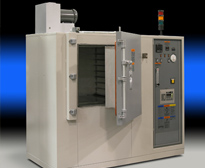Heat treating is the heating and cooling of metals and alloys to achieve a desired physical and mechanical property such as strength, hardness and resistance to fatigue or failure. Heat treating is a precise science that is made more complex by the varying properties of metal alloys. Understanding the properties of the material being heat treated is critical to achieving the desired outcome. Often times multiple heat-treating steps are necessary to produce the properties required for the final product.
Benefits of Despatch ovens and furnaces for heat treating:Heat treating often requires processing at high temperatures for extended periods making energy efficiency a high priority. Despatch ovens and furnaces have thick wall insulation, heavy-duty high temperature door gaskets and air that is recirculated through the heater box and back into the chamber for greater energy efficiency.
The consequence of uneven heat distribution during heat treating can be disastrous. Choosing a Despatch oven or furnace will ensure you that temperature uniformity will be well within specification. Despatch ovens feature high velocity uniflow airflow, meaning that the air moves both horizontally and vertically, offering exceptional temperature uniformity. Adjustable louvers direct heated air for a precise airflow pattern suited to specific parts.
Despatch ovens are available with a gas or electric heater and are available with Class A (NFPA 86) flammable solvent handling capabilities. They are built to withstand the rigors of industrial metal manufacturing with sturdy, welded, double wall construction.
Processes performed by Despatch ovens and furnaces:
Annealingproduces a uniform microstructure and softens metal to improve machinability.
(For information on annealing plastics visit our annealing page
)
Stress Relievingreduces internal stresses in metal caused by cold working or non-uniform cooling.
Aging, also referred to as precipitation hardening increases the hardness and strength of metal alloys. Both timing and temperature are critical during the hardening process. Uneven heating can create cracks and other defects, often starting from the corners or edges of the material. Materials that have been unevenly cooled, or soaked, can cause dark, vertical cracks that are irreparable.
Temperingis a process used to reduce the brittleness and increase the tensile strength of metal alloys after hardening.
Custom Heat Treat Furnaces
PNF Inert Atmosphere Oven for Aging Beryllium Copper
Despatch received an order for a PNF Inert Atmosphere Furnace for its beryllium copper aging process. A precondition of the order was that a test be performed to confirm that a uniformity of +/- 10℃ at 1000℃ could be maintained.

A Despatch engineer was sent to the customer’s facility to perform a field nine-point temperature uniformity test on the Despatch furnace currently in use. The oven was programmed to ramp and soak at three different temperatures and data collected. The furnace performed even better than expected with temperature uniformity between +/- 4.3℃ and 6.8℃ (2.4℉ and 3.8℉). The furnace is designed with adjustable recirculating air louvers that allow fine tuning to ensure uniform airflow.
